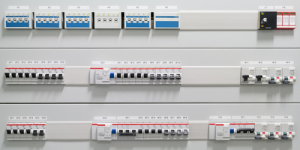Electrical code requires ground fault interrupter protection in more places than ever. For new construction or remodeling, this poses no inconvenience. But you might be wondering if you need to replace old outlets with GFCI outlets in an existing home. The short answer is that you definitely should for your safety’s sake, and you might be required to by code.
The code calls for a ground fault interrupter to protect circuits in areas that might be wet. The GFI detects a ground fault, which means power is flowing in an unintended direction. This helps keep you from getting shocked in places where that’s likelier to occur. Covered areas include:
- Kitchens (except refrigerators and disposals)
- Bathrooms
- Near wet bar sinks
- Unfinished garages
- Unfinished basements
- Laundry areas
- Outdoor areas
Note that you only need ground fault interrupter protection. Because a GFCI outlet will shut off power at all outlets further down the circuit from it, you don’t necessarily need a GFCI for every outlet in a room. You can use a GFCI breaker or place a GFCI outlet as the first outlet on the circuit.
Grandfather Clause for GFCI?
 When the NFPA updates the National Electrical Code, the changes typically apply to new homes or the next time you make a replacement or alteration in an existing home. In other words, if you have a non-GFCI outlet in a location that now requires protection by a ground fault interrupter, you do not need to replace it immediately.
When the NFPA updates the National Electrical Code, the changes typically apply to new homes or the next time you make a replacement or alteration in an existing home. In other words, if you have a non-GFCI outlet in a location that now requires protection by a ground fault interrupter, you do not need to replace it immediately.
The NEC grandfather rules do not last forever, though! You’re only grandfathered in until you make electrical upgrades in a location where the rules have changed.
For example, a ground fault interrupter has been required in the laundry room since the 2014 code. You cannot replace an old outlet in the laundry room with a new one if it does not have GFCI protection.
Pre-Home Inspection: Ground Fault Interrupter Installation
Home inspectors often jot down safety hazards and recommended changes, not just hard-and-fast code violations. When purchasing homeowner’s insurance or preparing to sell a house, you should ask a local electrician to update your home electrical system to reflect the current ground fault interrupter rules.
Upgrade with ground fault interrupter outlets or breakers, and you’ll have one less complaint to worry about from buyers, insurers, inspectors, or real estate agents.
Replace a 2-Prong Outlet with GFCI
Let’s say you have a two-prong outlet near your bathroom sink or on the kitchen counter. Two-prong outlets are not grounded, which means they can be dangerous to you and your appliances.
Replacing a two-prong outlet with a three-prong outlet does nothing except make it physically possible to plug in a three-prong appliance plug. The outlet still lacks grounding.
The good news is that you can replace a two-prong outlet with a GFCI outlet labeled “not grounded.” The outlet will not be grounded, but you will have improved safety and compliance.
Upgrade Outlets to GFCI
Electrical work such as replacing an outlet or adding a ground fault interrupter to the breaker panel should always be done by a licensed electrician. Some upgrades require a permit beforehand and an inspection afterward. More importantly, you don’t want shoddy work that could start a fire or hurt someone.
Ask Spyrka Electric about ground fault interrupter circuits and breakers if you’re planning a home improvement such as:
- Add more outlets
- Replace dead outlets
- Prep for home inspection
- Fix electrical code violations
- Electrical work for home remodeling
Contact us to schedule service and get up to code!

